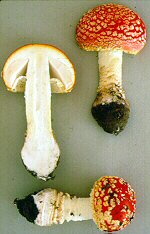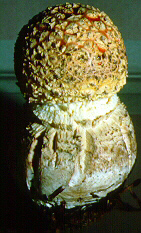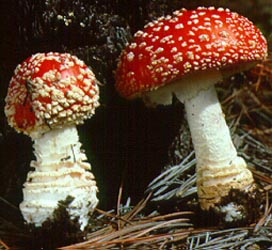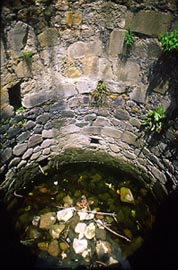|
[ Section Amanita page. ]
[ Amanita Studies home. ]
[ Keys & Checklist/Picturebooks ] "American Yellow-warted Fly Agaric" =Amanita muscaria var. flavivolvata (Singer) Dav. T. Jenkins
Technical description (t.b.d.) BRIEF DESCRIPTION: Amanita muscaria subsp. flavivolvata is the common, bright red fly agaric of North and Central America. The northwestern limit of its range (in Alaska, USA) overlaps with the northeastern end of the range of the Eurasian A. muscaria subsp. muscaria (L. : Fr.) Lam. Its cap is 50 - 215 mm wide and usually red in most of its range. The pigment rapidly fades in sunlight. Caps are most commonly yellow in the eastern half of Canada and the northeastern USA (these populations are called A. muscaria var. guessowii Veselý at present) or white in scattered populations in North America (these populations are called A. muscaria var. alba Peck at present). To date, molecular studies have not shown that the white and yellow populations are separable from red ones in terms of molecular phylogeny (Geml, 2008). The volva is distributed over the cap as yellow warts, and these also fade rapidly in sunlight. The last places to find yellow volval material are under the cap edge, under the annulus, and in the soil around the stipe base and bulb. The gills are free to narrowly adnate, crowded to subcrowded, and pale cream to pale yellowish white to white both in mass and in side view. The short gills are truncate. The stipe is 45 - 190 x 10 - 25 mm and has a skirt-like annulus and notable bulb of rather variable shape (19 - 61 x 18 - 50 mm). Rings of volval material commonly encircle the top of the bulb and the base of the stipe. The spores measure (7.5-) 9.0 - 12.8 (-19.0) x (5.5-) 6.5 - 8.5 (-11.5) µm and are broadly ellipsoid to ellipsoid (infrequently elongate, very rarely subglobose or cylindric) and inamyloid. This subspecies apparently contains the same toxins as Amanita muscaria subsp. muscaria
of Europe, northern Asia, and far northwestern North America (western Alaska with some yellow-capped populations in southwestern Canada and
into the northwestern US). Amanita muscaria subsp. flavivolvata occurs from lower altitudes in Alaska, through southwestern
Canada, through the Pacific coastal regions of the US, through the Sierra Nevada and the Rocky Mountains to the "mountain islands" of the
desert Southwest in the US and at least
as far south as the montane oak forests of Costa Rica. There are also significant populations in the U.S. Gulf Coast region.
Isolated occurrences of red-capped populations
The species is associated primarily with oak (Quercus) and diverse conifers, but can occur with other deciduous tree genera. As an aside, there is a cistern in a meadow formed by a long-dead crater on the volcano, La Malintzi, in the state of Tlaxcala, Mexico. Picnickers or perhaps those who pasture animals in the meadow make a practice of throwing fruiting bodies of A. muscaria subsp. flavivolvata into the cistern. See photo at right. [I am grateful to M. en C. Alejandro Kong Luz and M. en C. Adriana Montoya Esquivel (Universidad Autónoma de Tlaxcala) for taking me to the site on La Malintzi and describing to me how the mushrooms get into the cistern.] Dr. Bas taught me to use two, differing and unconnected characters to define a variety in Amanita and that the presence of three differing and unconnected characters justifies a species rank. Since mating experiments have never been managed in many ectomycorrhizal species (and certainly not in Amanita), we are left with "rules of thumb" such as Bas proposed. Since his approach has served the test of 40 years, I think it would be wise to continue to follow it. Creating a varietal name on the based of color (one character) has repeatedly led to problems. Dr Geml and his colleagues have provided a further illustration of the difficulties ensuing from creating new Amanita taxa differing only in a single character from a previously existing one. The term "form" might be applied in the case of a single character difference. But today we have seen the introduction of the rank "subforma" in Amanita. This seems to me to be unjustifiable. -- R. E. Tulloss Photos: R. E. Tulloss (top row - Arizona, California, Arizona)
[ Section Amanita page. ]
[ Amanita Studies home. ]
[ Keys & Checklist/Picturebooks ] Last changed 10 October 2009. |



 have been noted as far north as Massachusetts on the U.S. Atlantic Coast. Colombian
material may have been imported with pines. Argentine material that may be this taxon is also, clearly
imported, although the symbiont is not known to me. In
Argentina, the Eurasian A. muscaria var. muscaria has also been imported, in this case, on Eucalyptus.
have been noted as far north as Massachusetts on the U.S. Atlantic Coast. Colombian
material may have been imported with pines. Argentine material that may be this taxon is also, clearly
imported, although the symbiont is not known to me. In
Argentina, the Eurasian A. muscaria var. muscaria has also been imported, in this case, on Eucalyptus.